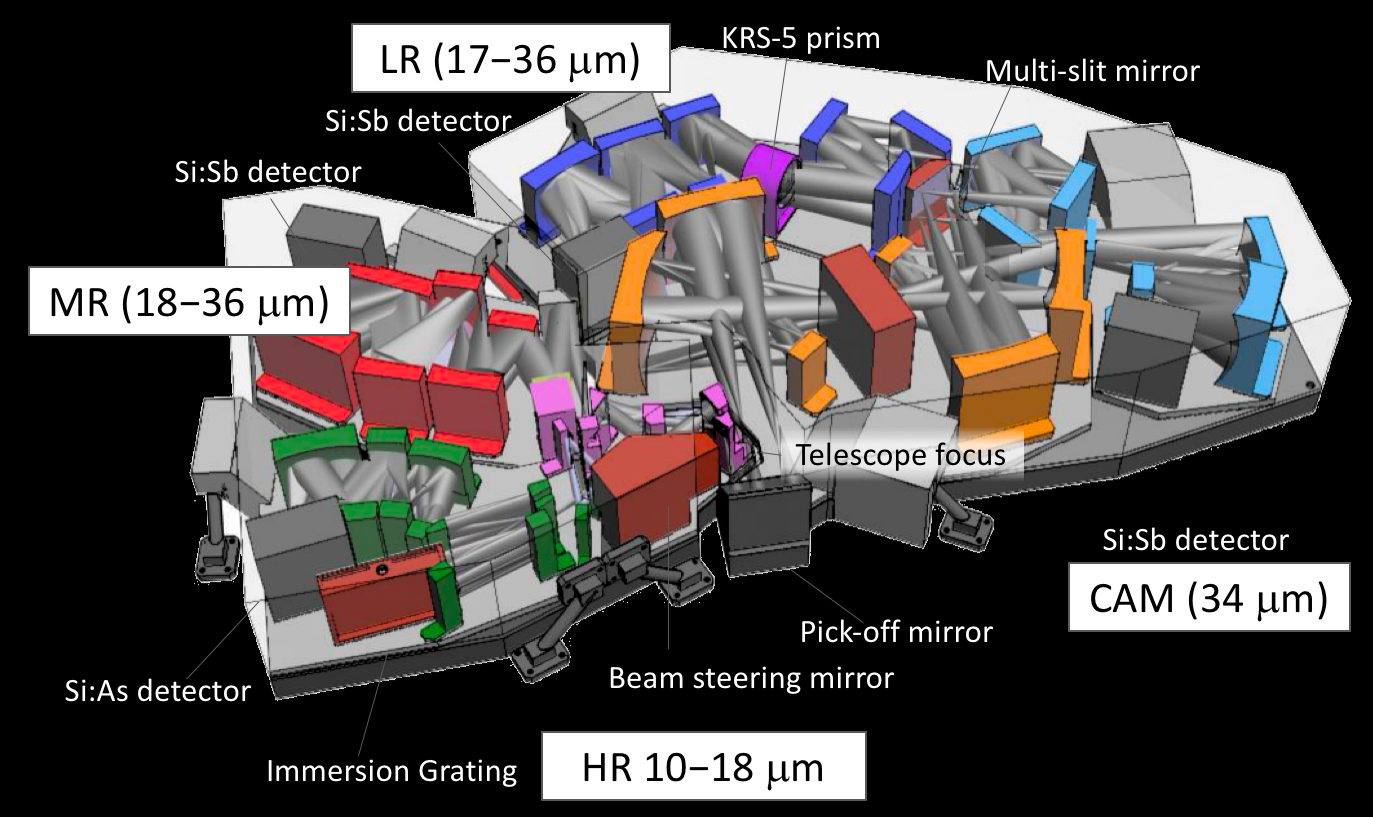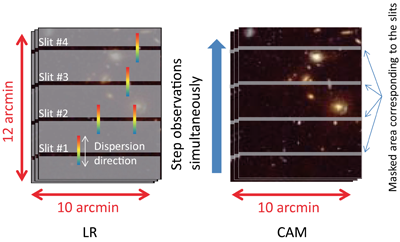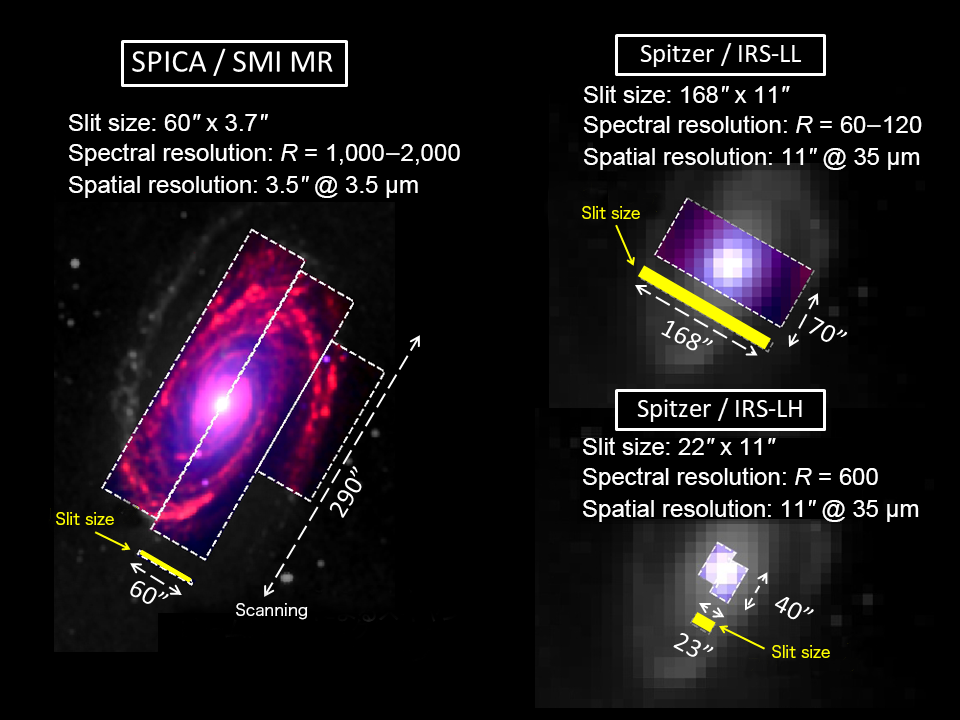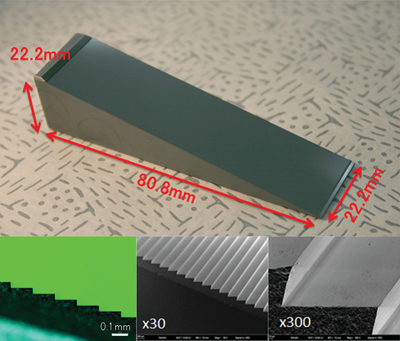Instrument
SMI is one of the three focal-plane science instruments to realize the scientific goals in the “SCIENCE” section. SMI covers the wavelength range from 10 to 36 μm with four separate channels: three spectrometers (LR, MR, and HR) and one imager (CAM) with an extreme sensitivity. SMI is the Japanese-led instrument proposed and managed by a nation-wide consortium in Japan and will be developed in collaboration with Taiwan and the US. In particular, ASIAA in Taiwan is a major partner for the development of the IR array detectors.

(Fig.) SMI optical and detector layout. The optics of LR/CAM and MR/HR is partially shared.
-
-

LOW-RESOLUTION SPECTROMETER (LR)
Low-resolution spectrometer (LR) is a multi-slit prism spectrometer using four 10 arcmin long slits to execute low-resolution (R=λ/Δλ=100) spectroscopic surveys with a continuous coverage over the 17–36 μm wavelength domain. LR will observe a huge number of distant (z>1) galaxies and active galactic nuclei as well as planet-forming regions, and probe dust mineralogy and composition via the mid-IR PAH (Polycyclic Aromatic Hydrocarbon), silicate features, and others.
(Fig.) The concept of the LR spectral mapping method; the multi-slit spectrometer LR and the slit viewer CAM are operated simultaneously, providing multi-object LR spectra at 17–36 μm and broad-band deep images at 34 μm, respectively. By operating LR and CAM simultaneously, wide area surveys with high speed and high sensitivity can be realized (Kaneda et al. 2017, PASA).
Wide Field Camera (CAM)
In LR, a 10 arcmin x 12 arcmin slit-viewer camera (CAM, a broad-band imager centered at 34 μm) is implemented to accurately determine the positions of the slits on the sky for pointing reconstruction in creating spectral maps. In the LR spectral mapping mode the multi-slit spectrometer and the camera are operated simultaneously. We plan to a photometric survey using SMI/CAM, which is the deepest one at 34 μm.
-

Mid-Resolution Spectrometer (MR)
Mid-resolution spectrometer (MR) is a spectrometer with 1 arcmin slit length and an echelle grating. MR covers a wavelength range of 18–36 μm with a high sensitivity and a medium spectral resolution of R=λ/Δλ=1,000. MR can observe the distant galaxies and planet-forming regions detected by LR and other various objects. MR is equipped with a beam-steering mirror so that it can conduct fast mapping observations of several arcmin regions without changing the satellite attitude. This will be very useful for spectral mapping of nearby galaxies.
(Fig.) Comparison between the survey speed of MR and that of Spitzer Infrared Spectrograph (IRS). For each instrument, the observation area is indicated in the same amount of time and with the same sensitivity.
-

High-Resolution Spectrometer (HR)
High-resolution spectrometer, HR, is designed to cover the wavelengths λ = 10–18 μm. With its high spectral resolving power (R=λ/Δλ=28,000), HR can be used to study the dynamics of molecular gas around active galactic nuclei and young stars. It allows us to study the molecular outflows driven by the active galactic nucleus and the formation of planetary systems. In general, a large size spectrometer is required to obtain high spectral resolution. However, since an instrument aboard a space craft is restricted by the size and weight, HR employs an immersion grating. The immersion grating is being developed with the cooperation of LiH at Kyoto Sangyo University.
(Fig.) CdZnTe immersion grating under development at LiH (Ikeda et al. Appl. Opt. 54, 5193 (2015))
-
Fact Sheet
 (Ver.13.1, September, 21, 2020, PDF version)
(Ver.13.1, September, 21, 2020, PDF version)
© 2018-2020 BY ISAS/JAXA | ALL RIGHTS RESERVED